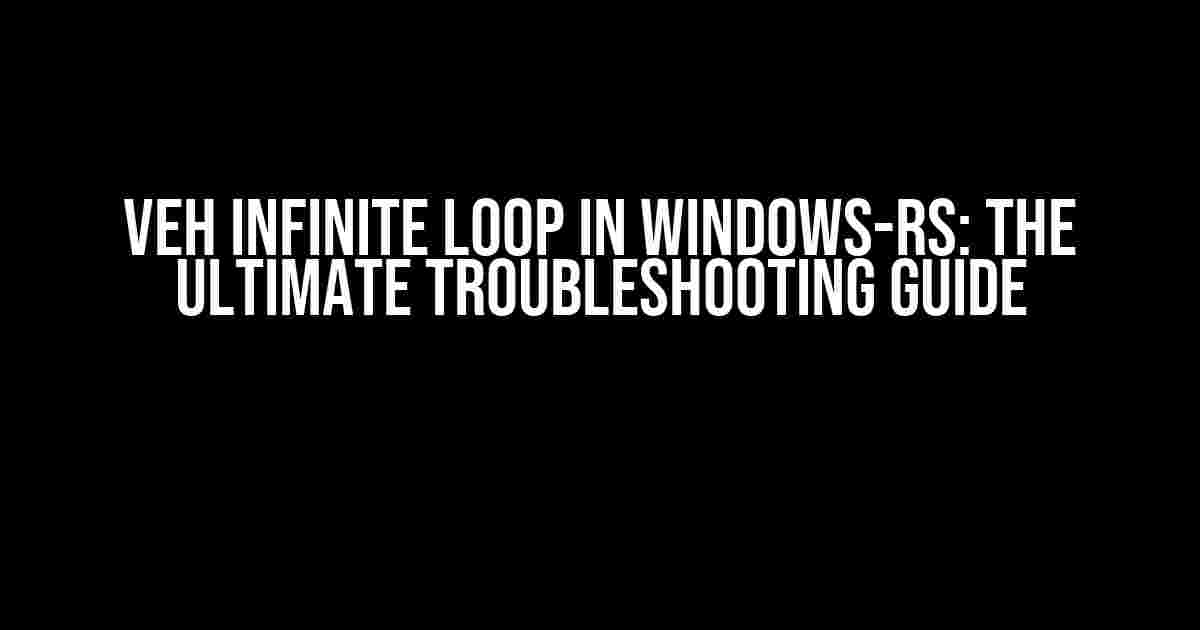Are you tired of your Windows-RS system getting stuck in an infinite loop, refusing to boot up or freezing at the login screen? You’re not alone! The VEH (Verified Execution Handler) infinite loop is a common issue that can drive even the most patient users crazy. But fear not, dear reader, for we’re about to embark on a thrilling adventure to troubleshoot and conquer this pesky problem once and for all!
What is a VEH Infinite Loop?
A VEH infinite loop occurs when the Windows-RS kernel gets stuck in an everlasting cycle of executing a specific instruction or set of instructions, causing the system to hang or freeze. This can happen due to various reasons, including:
- Corrupt system files or registry entries
- Incompatible or malfunctioning drivers
- BIOS or firmware issues
- Overheating or hardware failure
- Malware or virus infections
Symptoms of a VEH Infinite Loop
So, how do you know if you’re a victim of the VEH infinite loop? Look out for these common symptoms:
- Your system freezes or hangs at the login screen or during boot-up
- The Windows-RS logo is stuck on the screen, refusing to progress
- You see a continuous loop of error messages or beeps
- Your system restarts repeatedly, failing to enter the desktop
- You notice high CPU usage or disk activity, even when the system is idle
Troubleshooting Steps to Resolve the VEH Infinite Loop
Now that we’ve identified the problem, it’s time to get our troubleshooting gears in motion! Follow these steps carefully to resolve the VEH infinite loop:
-
System Restore
Boot your system in Safe Mode and try performing a System Restore to a previous point when the system was working correctly.
c:\windows\system32\rstrui.exe -
Disable Fast Startup
Disable Fast Startup to ensure that Windows-RS loads correctly:
reg add "HKLM\SYSTEM\CurrentControlSet\Control\Session Manager\Power" /v HiberbootEnabled /t REG_DWORD /d 0 /f -
Run a System File Checker (SFC) Scan
Run an SFC scan to identify and replace corrupt system files:
sfc /scannow -
Run a DISM Scan
Run a DISM scan to repair corrupted system files and registry entries:
dism /online /cleanup-image /restorehealth -
Update Windows-RS and Drivers
Ensure that Windows-RS and all drivers are up-to-date, as outdated drivers can cause VEH infinite loops:
Open the Settings app Update & Security Windows Update Check for updates -
Run a Malware Scan
Run a full scan with your antivirus software to detect and remove any malware or viruses:
msconfig /startup -
Check for BIOS or Firmware Updates
Check with your system manufacturer for BIOS or firmware updates, as outdated firmware can cause VEH infinite loops:
- Visit the manufacturer’s website
- Download the latest BIOS or firmware update
- Follow the instructions to update your system’s firmware
-
Perform a Clean Boot
Perform a Clean Boot to isolate the problem and identify if a third-party service or application is causing the VEH infinite loop:
msconfig /startup -
Reinstall Windows-RS
As a last resort, reinstall Windows-RS to start with a clean slate:
- Backup your important files and data
- Download the Media Creation Tool from Microsoft’s website
- Follow the instructions to reinstall Windows-RS
Conclusion
Troubleshooting a VEH infinite loop in Windows-RS can be a daunting task, but with these steps, you should be able to identify and resolve the issue. Remember to be patient, persistent, and methodical in your approach. Don’t hesitate to seek help from online forums, Microsoft support, or a professional if you’re stuck or unsure about any of the steps.
By following this comprehensive guide, you’ll be well on your way to banishing the VEH infinite loop and enjoying a smooth, error-free Windows-RS experience. Happy troubleshooting!
Note: This article is for informational purposes only and should not be considered as professional advice. Always follow proper troubleshooting procedures and seek help from authorized support channels if needed.
Frequently Asked Question
Get the scoop on VEH infinite loop in Windows-RS and put an end to the frustration!
What is VEH infinite loop in Windows-RS, and why is it driving me crazy?
A VEH (Verified Exception Handling) infinite loop in Windows-RS occurs when an exception is continuously thrown and caught, causing a loop that can’t be exited. This frustrating issue can lead to system crashes, freezes, or even BSODs. It’s like having a digital hamster on a wheel, going nowhere fast!
What are the most common causes of VEH infinite loop in Windows-RS?
The usual suspects include driver issues, faulty system files, registry errors, and even malware infections. Sometimes, a software or hardware conflict can also trigger this loop. Think of it like a digital game of Jenga – one wrong move, and the whole system comes crashing down!
How do I diagnose a VEH infinite loop in Windows-RS?
To diagnose the issue, you can use tools like the Windows Debugger (WinDbg) or the Reliability Monitor to analyze system crash dumps and identify the problematic driver or system component. It’s like being a digital detective, following the clues to uncover the root cause of the problem!
Can I fix a VEH infinite loop in Windows-RS on my own, or do I need professional help?
While it’s possible to try and fix the issue yourself by updating drivers, running system file checks, and performing registry repairs, it’s often recommended to seek professional help from a Windows expert or the system manufacturer’s support team. After all, you wouldn’t want to risk making things worse and ending up with a digital mess on your hands!
Are there any preventative measures to avoid VEH infinite loop in Windows-RS?
To minimize the risk of a VEH infinite loop, make sure to keep your system and drivers up-to-date, avoid overclocking, and install reliable software. It’s like taking out an insurance policy for your digital well-being – a little caution can go a long way in preventing this frustrating issue!


